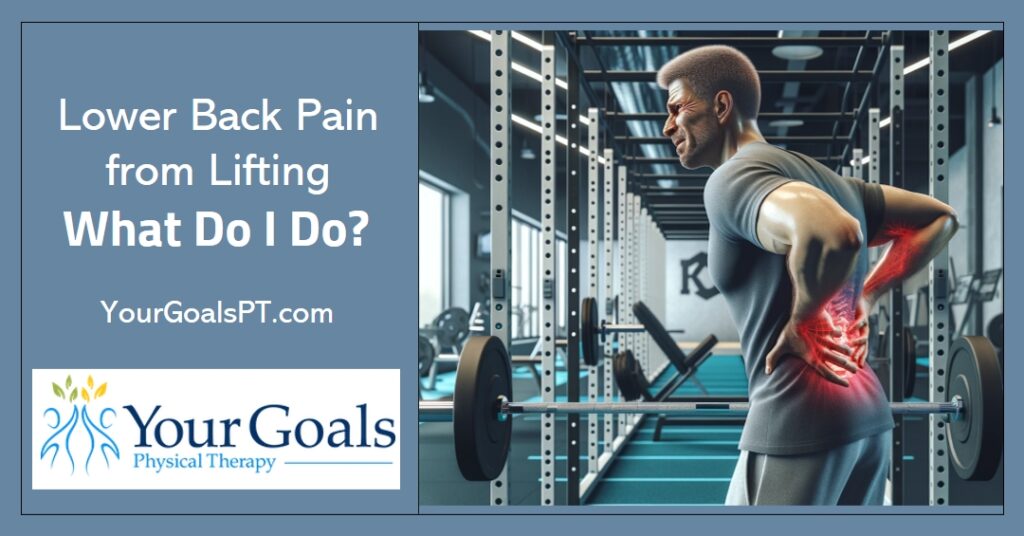
Are you suffering from lower back pain after lifting? And you’re wondering what you should do? This video is perfect. That’s exactly what I’m gonna talk about. My name is Dr. Molly and I’m with Your Goals Physical Therapy.
Tom came to me after several months, like six months, worth of dealing with lower back pain after he was at the gym and he went down for a squat. As he was coming up, his lower back just grabbed him and wouldn’t let go. He was able to re-rack his weights and after sitting for a little bit the pain kind of subsided. But over all the back pain stayed with him for a very long time, so long that he was afraid to lift. His back would ache when he sat for too long, while transitioning from sitting in his car to standing, and if he sat for too long on his couch, this nagging pain just persisted
It was so uncomfortable that he wasn’t even going to try to lift because obviously something was wrong. After two or three weeks, he went to his doctor. His doctor took X-rays and told him there was nothing wrong.
Well, that actually frustrated Tom even more because he’s like, “there’s pain, there’s obviously something wrong.” He wasn’t too thrilled with that. And again, this pain persisted for a very long time, even after taking the muscle relaxers, the doctor gave him and resting like the doctor told him.
He was still very frustrated that he wasn’t able to get back to lifting. So during our first meeting, it was very apparent that Tom looked at being able to lift weights and go to the gym as not only his time away to like decompress from his job and his family, but also a huge sign of his health and being able to stay young and do the things that he wanted to do.
He saw going to the gym as the way that you stay on track and, um, that you stay healthy and so not being able to go to the gym was affecting him in a lot of ways. He really was nervous that he wasn’t gonna be able to go back to lifting the way that he liked to lift. He wasn’t really interested in lifting lighter weights, which is one of the things the doctor told him. The last thing that he was, again, I’ll reiterate how frustrated he really was when the doctor told him there was nothing wrong with his back, knowing that he was uncomfortable.
I started by going over the anatomy of his lower back. Then I talked to him about very specific things he could do at home, which I will share with you to help calm down his pain. I know that lots of people have tried physical therapy and when they’re trying to get back to lifting, there always seems to be a disconnect. They get out of pain while they’re in therapy, but they might not be able to lift the way that they went. So I’m gonna talk a little bit about that later on in the video also.
The anatomy of your lower back, your lower back is made up of five bones that have cushions between them that help you with shock absorption. You have ligaments that surround that making a very good scaffolding. If you’ve ever looked at a spine, the way that the spine is designed, it has a specific intent to keep your spinal cord very, very safe. There are a lot of bony prominences, there are lots of ligaments everywhere. Everybody thinks that your low back muscles are the things that keep you stable. Ultimately all your low back muscles are designed to do is keep your spine in its normal alignment. So if you have an increased curve, that means your back muscles are doing more work because they’re shortening and they’re just constantly on tension.
If you have a complete reversal of that normal curve, now those muscles are overstretched and then can become weak or create muscle spasms. Due to the way that we sit and stand and move, oftentimes many people go from one extreme to the other. You go from completely reversing the curve in your lower back to completely hyperextending the curve in your lower back, all depending on if you’re sitting or standing. And so this can really wear out your lower back before you even get to exercising.
The main muscle group that is supposed to help keep your spine stable while you’re moving, are actually your abdominal muscles. So the health of your back is not necessarily determined by the strength of your low back muscles, which of course do play a role, but the stability of your spine is really a measure of how strong your abs. In addition to being directly related to, or they have a really close relationship with how flexible and strong your hips are as well.
For instance, you’re supposed to hinge at your hips for everything. By hinging at your hips, then your low back doesn’t have to flex forward or back for you to get your trunk to come down closer to the ground to pick things up, to move things around, right? So if you have very tight hips, like if your hamstrings are tight or your hip flexors are tight, that will directly affect how much you have to use your low back.
And like I was mentioning before, when we have to go through those extreme movements in our back, we’re inadvertently wearing our back out and making things fatigued and weaker without necessarily realizing it because it doesn’t always cause pain until it’s just overdone.
Now if I get back to Tom after that anatomy, he came in and he was having some very acute lower back pain. One of the first things I suggested he do when he got home is to lay flat on, uh, it doesn’t matter, it could be your bed or the ground. Just be in a comfortable position and put an ice pack on. But like many people, Tom couldn’t actually lay flat because it hurt his lower back. So, what I told him to do is to use pillows to build up his hips so that he could still be on his stomach and laying down, but without having too much stress on his back. He was able to find a comfortable position like that and lay with ice on top of his lower back. Icing help calm down inflammation. Overuse muscles that are strained or causing a muscle spasm by putting ice on it, you help alleviate some of that inflammation.
The next thing I showed him was a few lower back stretches. I stressed a lot the idea that a stronger stretch is not necessarily better. You really just wanna barely feel a stretch, barely be uncomfortable. If you’re dealing with low back pain because of a severe muscle spasm and you go cranking into these stretch positions, all you’re gonna do is cause that muscle to contract even harder and you’ll have more pain and more discomfort.
We practiced how to gently stretch his back. We did try a few stretches to see what would work for Tom. We tried what they call a single knee chest. We tried a double knee to chest, we tried lower trunk rotations. And finally we tried child’s pose, all very gentle.
You can control how hard you pull and it really depends on the person on which ones work best for them. The rest of the time we looked at hip flexibility, core stability, all these little parts because his ultimate goal is to get back to squatting. He wants to be able to squat more than the weight that he got injured lifting. So we needed to start from where he was and then work on getting to his goal.
This would be one of my biggest suggestions, no matter who you choose to help you resolve your low back pain, if your goal is to get back to lifting a certain weight or getting back to a sport, you need to work with a physical therapist or a movement specialist that is gonna take your goal to heart. Someone who will set up a plan to achieve just that goal.
Just getting Tom out of pain is probably gonna take, maybe three or four sessions to have his pain stop. But that’s not when the healing stops. If you injured yourself and now you’re just out of pain, are you really strong enough to get back to the sport that you want? Are you really stable enough to get back to doing what you want?
There’s lots of research out there that shows that specifically with back injuries, because it is so complicated, it doesn’t just take two or three sessions to fully heal. As in to heal enough to not deal with this problem again. For that complete healing it takes a certain level of strength and strength just takes time to develop. So that was how we set up our program with Tom. We had milestones that we were gonna hit to help him achieve his goal that he ultimately wanted to lift. When Tom completed his program, he was no longer frustrated with the fact that the doctor said there was nothing wrong. He actually understood what that doctor really meant was that there was no structural damage, which is good, right?
That’s always a good thing. However, his lower back muscles were overworked. He and I were able to work on calming his back muscle down, stopping his pain while getting him strong enough to squat at the same level before injury without any complications or setbacks.
If this is the type of care that you’re looking for, that is fabulous, because that’s what I love to help people do. I love to help people get back to their favorite sports. So much so that I even created an online book, an ebook, for “How to keep your back from going out more often than you do”. Lower back pain is a huge issue and lots of people are dealing with it. You shouldn’t have to deal with it any longer than you already have.
I’ve put together my best tips. If you’re looking for a little bit more information, there’ll be a link for that.
If you are having a specific concern and maybe you really have had therapy and you’ve tried all these things and you’re just wondering what, if anything I can offer that would be different, I’m gonna leave a form. You can fill that form out and let me know a time or a day or a time that’s good for you. I will get back to you. We’ll set up a 20 minute call so that you can ask me all the questions. If we end up being a good fit, we can set up the next steps to work together. And if not, you will have more information on how to get the help that you do need. I hope that everybody’s having a great day, and I’ll talk to you soon. Bye.
We help active adults end their aches and pain, so they can reclaim their favorite recreational activities and live life to the fullest.

MEDICAL DISCLAIMER:
All information on this website is intended for instruction and informational purposes only. The authors are not responsible for any harm or injury that may result. Significant injury risk is possible if you do not follow due diligence and seek suitable professional advice about your injury. No guarantees of specific results are expressly made or implied on this website.